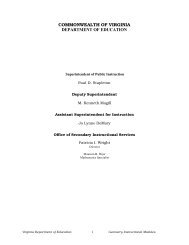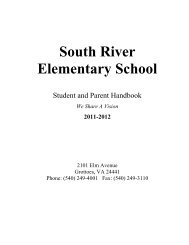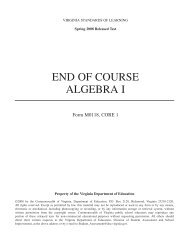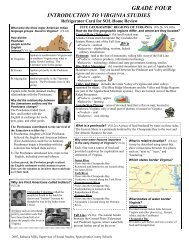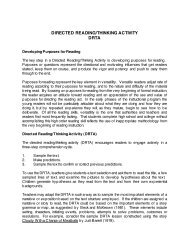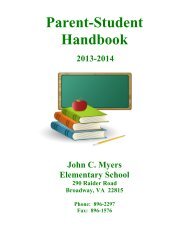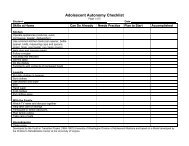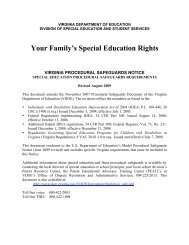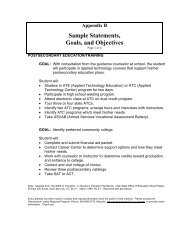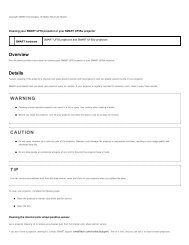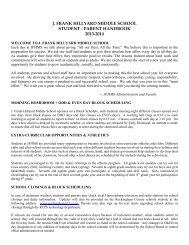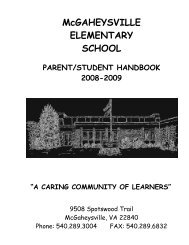504 Information - Rockingham County Public Schools
504 Information - Rockingham County Public Schools
504 Information - Rockingham County Public Schools
You also want an ePaper? Increase the reach of your titles
YUMPU automatically turns print PDFs into web optimized ePapers that Google loves.
The Americans with Disabilities Amendments Act of 2008 (effective January 1, 2009) amended the<br />
Americans with Disabilities Act of 1990 and included a conforming amendment to the Rehabilitation Act<br />
of 1973.<br />
This handbook provides information for the implementation of the procedural provisions for services to<br />
students identified under §<strong>504</strong> of the Rehabilitation Act of 1973, as amended (§<strong>504</strong>). Components of this<br />
Act prohibit discrimination against disabled persons by school districts receiving federal financial<br />
assistance. This includes all programs and activities of the school district receiving federal funds,<br />
regardless of whether the specific program or activity involved is a direct recipient of federal funds.<br />
“Section §<strong>504</strong>” means that section of the Rehabilitation Act of 1973, as amended, which is designed to<br />
eliminate discrimination on the basis of disability in any program or activity receiving federal financial<br />
assistance.<br />
It is the intent of the <strong>Rockingham</strong> <strong>County</strong> <strong>Public</strong> School system to ensure that students who are disabled<br />
as defined under §<strong>504</strong> criteria are identified, evaluated and provided with appropriate educational<br />
services.<br />
Students may be disabled under this policy even though they do not require services pursuant to the<br />
Individuals with Disabilities Education Act (IDEA). In other words, a student may have a disabling<br />
condition (as defined by §<strong>504</strong>) but evidence no significant cognitive or academic impairment (thus not<br />
IDEA eligible) yet remain eligible for receipt of related services and/or accommodations.<br />
All procedural safeguards afforded to students with disabilities considered eligible under §<strong>504</strong> are<br />
guaranteed by the <strong>Rockingham</strong> <strong>County</strong> <strong>Public</strong> School system.<br />
NONDISCRIMINATION<br />
<strong>Rockingham</strong> <strong>County</strong> <strong>Public</strong> <strong>Schools</strong> does not discriminate against any individual for reasons of race,<br />
color, national origin, religion, sex (including pregnancy), gender, marital or economic status, age,<br />
disability, genetics, or veteran status. Furthermore, the school division does not retaliate against anyone<br />
who files a complaint of discrimination or participates in such a proceeding. The school division’s<br />
nondiscrimination policy is located at School Board Policy AC.<br />
ELIGIBILITY<br />
To be eligible under §<strong>504</strong>, a student must be “qualified” and “handicapped.” Under 324 C.F.R. §104.3(j)<br />
(1) of the regulations (as amended), “handicapped” (a term which has been replaced with “disabled”) is<br />
defined as follows:<br />
Any person who:<br />
• has a physical or mental impairment that substantially limits one or more major life activities;<br />
• has a record of such an impairment, or<br />
• is regarded as having such an impairment.<br />
The second and third sections cover persons with a history of a disability or persons who are perceived as<br />
having a disability. The second and third sections create a very different type of §<strong>504</strong> eligibility. While a<br />
“record of” an impairment or being “regarded as having” an impairment by the recipient give rise to antidiscrimination<br />
protection under §<strong>504</strong>, these two prongs do not trigger <strong>Rockingham</strong> <strong>County</strong> <strong>Public</strong><br />
School’s obligation to provide a free and appropriate public education (FAPE).<br />
1
These two prongs are meant to reach situations where individuals either were or are “considered” to be<br />
disabled, and are currently being treated by others as if they were. Consequently, the only duty as to these<br />
students is to not discriminate against them on the basis of the history or perception of impairment.<br />
PHYSICAL OR MENTAL IMPAIRMENT<br />
The first prong of the definition of a disability focuses on current identified disabilities. A physical or<br />
mental impairment is defined as:<br />
• any physiological disorder or condition, cosmetic disfigurement, or anatomical loss affecting one<br />
or more of the following body systems: neurological; musculoskeletal; special sense organs;<br />
respiratory, including speech organs: cardiovascular; reproductive; digestive; genitor-urinary;<br />
hemic and lymphatic; skin and endocrine; or<br />
• any mental or psychological disorder, such as mental retardation, organic brain syndrome,<br />
emotional or mental illness, and specific learning disabilities.<br />
Unlike the Individuals with Disabilities Education Act (IDEA), §<strong>504</strong> does not list specific disability<br />
categories. While the “physical or mental impairment” language is designed to include virtually anything<br />
that can happen to your body or your mind, the narrowing of eligibility under §<strong>504</strong> occurs through the<br />
substantial limitation language (discussed below). That is, to be eligible, one must have:<br />
• the required impairment; and<br />
• the impairment must be of a certain level of severity in terms of its impact on the individual.<br />
Major Life Activities<br />
Major life activities include the following:<br />
• caring for one’s self<br />
• performing manual tasks<br />
• walking<br />
• seeing<br />
• hearing<br />
• speaking<br />
• breathing<br />
• learning<br />
• working<br />
• eating<br />
• sleeping<br />
• standing<br />
• lifting<br />
• bending<br />
• reading<br />
• concentrating<br />
• thinking<br />
• communicating<br />
In addition, major life activities also include the operation of a “major bodily function” including<br />
functions of immune system, normal cell growth, digestive, bowel, bladder, neurological, brain,<br />
respiratory, circulatory, endocrine, and reproductive functions.<br />
2
The above list of major life activities is non-exhaustive.<br />
SUBSTANTIAL LIMITATION<br />
To have a disability an individual must be substantially limited in performing a major life activity as<br />
compared to most people in the general population. An impairment need not prevent, or significantly or<br />
severely restrict, the individual in performing a major life activity to be considered “substantially<br />
limiting.” The determination of whether an individual is experiencing a substantial limitation in<br />
performing a major life activity is a common-sense assessment based on comparing an individual’s ability<br />
to perform a specific major life activity (which could be a major bodily function) with that of most people<br />
in the general population.<br />
Thus, in order to qualify as an individual with a disability, there must be a physical or mental impairment<br />
that “substantially limits” a “major life activity” such as caring for one's self, performing manual tasks,<br />
walking, seeing, hearing, speaking, breathing, learning, reading, concentrating, thinking, communicating,<br />
sleeping, eating, lifting, bending, working and a condition affecting the operation of a major bodily<br />
function such as the immune system, normal cell growth, digestive, bowel, or bladder functions. This list<br />
of major life activities is not exhaustive.<br />
The §<strong>504</strong> regulations do not contain a definition of substantial limitation. The Department of Education<br />
has declined to define the term but has indicated that the determination of whether a particular impairment<br />
substantially limits a major life activity is left up to a student’s §<strong>504</strong> team.<br />
The phrase “major life activities” is calculated to include “those basic activities that the average person in<br />
the general population can perform with little or no difficulty.” The student need not have a disability<br />
limiting the major life activity of learning to qualify. The student may not have a disability that adversely<br />
affects the ability to learn, yet may require assistance from the school system to access learning. For<br />
instance, a child may have a very severe asthma condition (affecting the major life activity of breathing)<br />
that requires regular medication and regular use of an inhaler while in school. Without regular<br />
administration of the medication and inhaler, the student cannot remain in school, thus learning and<br />
breathing is impacted. The §<strong>504</strong> plan could, at a minimum, formally address the use of the inhaler.<br />
A major life activity is substantially limited when the “individual’s important life activities are restricted<br />
as to the conditions, manner or duration under which an individual can perform a particular major life<br />
activity as compared to the condition, manner or duration under which the average person in the general<br />
population can perform the major life activity.” The comparison defining eligibility is relative to<br />
“average potential,” not “best” conceivable in the absence of a disability. The limitation does not need to<br />
be active (may be in remission) and “mitigating measures” (such as medication or hearing aids) should<br />
not negate eligibility. The corrective effects of mitigating measures cannot be considered in determining<br />
whether or not a person is disabled. The regulations list the following factors for use in evaluating<br />
whether someone is substantially limited in a major life activity:<br />
• “The nature and severity of the impairment;<br />
• the duration or expected duration of the impairment; and<br />
• the permanent or long-term impact, or the expected permanent or long-term impact of or<br />
resulting from the impairment.”<br />
The determination of whether an impairment substantially limits a major life activity shall be made<br />
without regard to the ameliorative effects of mitigating measures.”<br />
Mitigating measures include:<br />
3
• Medication;<br />
• Medical supplies, equipment, or appliances;<br />
• Low-vision devices (not including ordinary prescription wear);<br />
• Prosthetics;<br />
• Hearing aids, implants, and devices;<br />
• Mobility devices;<br />
• Oxygen therapy equipment and supplies;<br />
• Assistive technology;<br />
• “Reasonable accommodations;”<br />
• Auxiliary aides or services, including interpreters for the hearing impaired and readers for the<br />
visually impaired; and<br />
• Learned behavioral or adaptive neurological modifications.<br />
The effects of mitigating measures may not be taken into account in determining whether a student’s<br />
impairment results in a substantial limitation, except eye glasses and contacts. Thus, when evaluating<br />
whether a student is eligible under §<strong>504</strong>, the team must consider the supposed or hypothetical degree of<br />
limitation in the absence of medication or other mitigating measures.<br />
As such, while considering a student’s eligibility under §<strong>504</strong>, it is appropriate to consider the necessity<br />
for a systematic and consistently implemented battery of modifications, over an extended period of time,<br />
in order to have the student’s needs met as adequately as non-disabled students. If such a systematic,<br />
long-term battery is not necessary, then §<strong>504</strong> eligibility may not be appropriate.<br />
A student with a temporary disability (e.g., burns, broken limbs, short-term illness, etc.) might be eligible<br />
under §<strong>504</strong>. Temporary disabilities must be resolved on a case-by-case basis, taking into consideration<br />
both the duration (or expected duration) of the impairment and the extent to which it actually limits a<br />
major life activity. Note that the Virginia Department of Education does allow for identification as a<br />
student with a §<strong>504</strong> qualifying disability as a temporary condition relative to the availability of specific<br />
accommodations for Standards of Learning (SOL) assessments.<br />
THE §<strong>504</strong> PROCESS<br />
1. Child Find<br />
<strong>Rockingham</strong> <strong>County</strong> <strong>Public</strong> <strong>Schools</strong> maintains on-going child find activities in an effort to identify and<br />
locate every qualified individual residing in <strong>Rockingham</strong> <strong>County</strong> who is not receiving a public education.<br />
An annual notice is provided through local publication that acts to notify disabled students and their<br />
parents of the obligation to provide a free appropriate public education. This does not extend, however, to<br />
students whose parents have unilaterally placed them in a private or home-schooling setting. With regard<br />
to such students, once the school system has offered the student a free appropriate public education, it has<br />
no responsibility to provide “educational services to students not enrolled in the public school program<br />
based on the personal choice of the parent or guardian” (OCR, 1993 [Hinds <strong>County</strong> School Board]) under<br />
§<strong>504</strong> regulations.<br />
2. Referral<br />
An initial evaluation may be generated on any child, aged two to twenty-one, inclusive, who resides<br />
within <strong>Rockingham</strong> <strong>County</strong>. This includes migrant and homeless children, children attending private<br />
schools (including home instructed), and students suspected of being disabled even though they are<br />
advancing from grade to grade. All such students, whether enrolled in public school or not, shall be<br />
4
eferred to the Director, Pupil Personnel or designee in order to initiate the process of determining<br />
eligibility for §<strong>504</strong> services.<br />
An evaluation must be conducted prior to the initial provision of §<strong>504</strong> services and prior to a subsequent<br />
significant change in placement to a student with a suspected disability. The evaluation components must<br />
be “sufficiently comprehensive” to identify all of the child’s special education and related services needs<br />
and must include a classroom observation or, in the case of a child of less than school age or out of<br />
school, a group member shall observe the child in an environment appropriate for a child of that age. Test<br />
materials must be validated for the specific purpose for which they are used and administered by trained<br />
personnel. Test materials must be designated to assess specific areas of educational need, and cannot<br />
merely be a general measure of intelligence.<br />
When a test is administered to a student with impaired sensory, manual, or speaking skills, the tests<br />
selected and administered should measure the student’s aptitude or achievement level rather than the<br />
student’s impaired sensory, manual, or speaking skills.<br />
School staff, a child’s parent(s)/guardian(s)/surrogate(s), a physician, community service agency, or any<br />
other source (in conjunction with parental permission) may generate a referral for an initial evaluation.<br />
It is the responsibility of the Student Study Committee (SCC) to determine, following intervention, if<br />
appropriate, if there is a suspicion of a disability. This determination follows a review of:<br />
• existing evaluation data;<br />
• current classroom-based assessments and observations;<br />
• information provided by the implementation of the intervention plan;<br />
• and information provided by the parent(s).<br />
This is the appropriate procedure to follow for all referrals, regardless of the point of origin. The SSC has<br />
no time constraints limiting exploration of alternatives within the general education program. When and<br />
if it becomes obvious that reasonable intervention strategies have not been effective and there is a<br />
concomitant suspicion of a disability, then the SSC has three (3) days to forward the referral to the<br />
Director of Pupil Personnel Services.<br />
Should the SSC not recommend an evaluation, resulting in parental objection, the prior written notice<br />
form (Form 90.10) must be completed and a copy presented to the parents. This occurs only in the<br />
absence of parental agreement, not when there is a lack of consensus among school staff.<br />
Upon receipt of the referral for evaluation, the Director, Pupil Personnel Services or designee shall assign<br />
assessment components. The sixty-five (65) business day timeline begins with the date of the referral to<br />
the Director (inclusive of the three day notification timeline).<br />
The 65 business day timeline shall not apply to the school division if:<br />
• the parent(s) of the child repeatedly fail or refuse to produce the child for the evaluation;<br />
• the child enrolls in a school served by the division (including private schools) after the required<br />
65 business day timeline has begun and prior to a determination by the previous school division<br />
as to whether the child is a child with a disability (“sufficient progress” to ensure prompt<br />
completion of the evaluation must be in effect); or<br />
5
• the parent(s) and the eligibility group agree in writing to extend the 65-day timeline to obtain<br />
additional data.<br />
The SSC shall obtain permission for evaluation from the parent(s)/guardian(s)/surrogate(s) and select the<br />
appropriate assessment components. The committee chairperson will:<br />
• complete Forms 30.00, 30.01, 30.02, and 30.03 (if signed at the meeting) and send to the<br />
Director of Pupil Personnel Services;<br />
• student study Forms 20.40 and 20.45 should accompany the referral;<br />
• give the parent(s) a copy of the §<strong>504</strong> Procedural Safeguard Requirements;<br />
• assign a “case manager” to oversee compliance with the assessment timelines; and<br />
• provide reasonable notice to the parent(s) of the date, time, and place of the eligibility meeting in<br />
compliance with state and federal regulations.<br />
The school principal has the primary responsibility for obtaining permission for the formal assessment<br />
and notifying the Director of Pupil Personnel Services. The referral must be accompanied by parental<br />
permission and the requested assessment components.<br />
Parental consent for the initial evaluation shall not be construed as consent for initial provision of special<br />
education and related services.<br />
If the parent(s) refuse permission for the proposed evaluation or parts of the evaluation, the SSC may:<br />
• accept the parent(s) decision and provide instructional leadership and consultation to the<br />
classroom teacher in an attempt to address the referral concerns; or<br />
• appeal the parental refusal to the Director of Pupil Personnel Services who may choose to<br />
employ regulatory mechanisms to obtain consent.<br />
Once consent has been secured and components assigned, the school system has sixty-five (65) business<br />
days to complete the assessment proceedings. A written copy of the evaluation report shall be provided to<br />
the parent(s) at the time of the meeting.<br />
At any time during the evaluation process the parent(s)/guardian(s)/surrogate(s) may request<br />
termination of the evaluation. It is recommended that such a request be presented in writing.<br />
However, if unable to obtain a written termination request, then the SSC must reconvene and<br />
document the request in the minutes. Such a request may be accepted or appealed as noted above.<br />
2. Referral<br />
The referral procedures are identical to those employed through the IDEA proceedings, including the use<br />
of the student study committee, intervention plans, and component selection options.<br />
3. Evaluation<br />
6
Initial/Triennial Evaluations<br />
The procedures regarding the evaluation of a student for determination of eligibility under §<strong>504</strong> are<br />
similar to those under IDEA. This includes evaluation component(s) selection, maintaining reasonable<br />
timelines, and prior notice requirements.<br />
Evaluation does not necessarily mean, “test.” In the §<strong>504</strong> context, “evaluation” refers to a gathering of<br />
data or information from a variety of sources so that the eligibility committee can make a decision<br />
following deliberations (Form 50.20). Although the usual avenue for consideration of §<strong>504</strong> eligibility<br />
would be that of following IDEA eligibility procedures there may be occasion when health information or<br />
medical diagnosis, for example, in combination with deficient academic performance data that clearly is<br />
related to the diagnosed condition (disability) may preclude the necessity of a more thorough evaluation.<br />
It is important to remember, however, that diagnosis of an impairment does not, in and of itself, define<br />
disability.<br />
A reevaluation is required “periodically” (e.g., every three years) for each student identified under §<strong>504</strong><br />
regulations, as amended. The evaluation shall be initiated no less than sixty-five (65) business days prior<br />
to the third anniversary of the date eligibility was last determined.<br />
As per current practice, the initial and first triennial review of the eligibility decision must consist of a<br />
complete evaluation. The second triennial review assessment components are determined by the SSC. If<br />
the SSC concludes that no additional evaluation components are necessary a parent of the student must be<br />
informed of the right to request evaluation components and must provide consent to the decision not to<br />
acquire additional assessment data. This will continue to be accomplished with the “30 series” forms. An<br />
eligibility group meeting will be convened to acknowledge continued eligibility. Form 50.20 with<br />
accompanying minutes will be sent to the Director, Pupil Personnel Service or designee.<br />
A change in the disability classification of a student requires an evaluation, regardless of circumstances.<br />
Procedures for a Triennial Re-Evaluation:<br />
1. The Director of Pupil Personnel Services (or designee) will initiate all triennials and secure<br />
parental consent.<br />
2. Pupil Personnel Services staff will notify the principal and special education teacher of the<br />
students need for a triennial re-evaluation.<br />
3. Each individual responsible for an assessment component should complete the evaluation by the<br />
date indicated on the referral form (30.00).<br />
Assessment Component(s) Determination<br />
Review of existing evaluation data (“status review”)<br />
As part of the triennial evaluation, the SSC, or a representative subgroup of the group [including regular<br />
education teachers and parent(s)/guardian(s)/surrogate(s), as appropriate], will:<br />
(a)<br />
review the reason for the triennial review, if applicable, and existing evaluation data on<br />
the student, including:<br />
• evaluations and information provided by the parent(s) of the child;<br />
7
• current classroom-based assessments and observations; and<br />
• observations by teachers and related services providers; and<br />
(b)<br />
identifies, on the basis of the above review, and input from the student’s parent(s), what<br />
additional data, if any, are needed to determine:<br />
• whether the child continues to have a particular disability or has any additional<br />
disabilities;<br />
• the present level of performance and educational needs of the student;<br />
• whether the student continues to need special education and related services; and<br />
• whether any modifications to the special education and related services are needed to<br />
enable the student to meet the measurable annual goals set out in the §<strong>504</strong> plan and to<br />
participate, as appropriate, in the general curriculum.<br />
By state regulation, if no additional data is necessary to continue eligibility and with no change relative<br />
to the child’s current §<strong>504</strong> classification, this review may be conducted without a meeting. However,<br />
“best practice” will continue to be the scheduling and completion of an eligibility group meeting.<br />
Minutes of the meeting, albeit brief, along with Form 50.20, will be sent to the Director, Pupil Personnel<br />
Services or designee.<br />
Although not regulatory, there should be a historical record of at least two sets of evaluation data prior to<br />
approving such a decision.<br />
Parent permission is not required to conduct this review, however, parental approval of the decision not to<br />
obtain any additional data is mandatory. So, in other words, we will continue to obtain consent to<br />
conduct the review by the eligibility group even when no additional data is requested or necessary to<br />
continue eligibility under the existing classification.<br />
If no additional data is requested, this process shall be considered the triennial evaluation. As such, an<br />
eligibility meeting will be convened to acknowledge this decision and to document staff and parental<br />
approval (Form 50.20). If additional assessment data is necessary to conduct the review, the Director,<br />
Pupil Personnel Services or designee must assign the evaluation components within sixty-five (65)<br />
business days of the triennial anniversary of the prior (most recent) eligibility group meeting.<br />
Parental refusal to participate in the triennial evaluation process must be forwarded to the Director, Pupil<br />
Personnel Services for procedural review.<br />
Review Assessments<br />
A. A review of a student’s §<strong>504</strong> classification should be conducted when:<br />
• A child’s parent(s) or school staff submits a request. This request should be submitted<br />
through the Student Study Committee and Form 20.40; 20.45; 30.00; 30.01; 30.02; 30.03 sent<br />
to the Director, Pupil Personnel Services.<br />
• If conditions warrant a review of the student’s educational needs at an earlier date other than<br />
the scheduled triennial evaluation.<br />
B. Relative to component selection, a review assessment is conducted in the same manner as an<br />
initial evaluation.<br />
8
C. Parental refusal to participate in the review process must be forwarded to the Director, Pupil<br />
Personnel services for procedural review.<br />
“Transfer” Evaluations<br />
In keeping with state and federal regulations, a student who is entering the <strong>Rockingham</strong> <strong>County</strong> <strong>Public</strong><br />
School division as a “transfer” student with a disability and a §<strong>504</strong> plan from another division or school<br />
within the state of Virginia is not required to receive a complete special education evaluation. The first<br />
triennial review, however, must, pending parental consent, consist of the psychological, educational, and<br />
sociocultural evaluations, at a minimum.<br />
If, upon review of existing records, the SSC feels that an evaluation should be initiated immediately, or at<br />
any time before the anniversary of the triennial review date, consent may be sought to begin the process.<br />
It is not mandatory to wait until the triennial review date before seeking consent to evaluate. Such an<br />
evaluation request should be treated as a “review” assessment and all procedures noted above should be<br />
followed accordingly.<br />
Out-of-state transfers continue to require a complete (classroom observation, educational, psychological,<br />
sociocultural) evaluation upon arrival.<br />
If a transfer evaluation is necessary or requested, the school is responsible for completing the following:<br />
• secure a copy of the student’s §<strong>504</strong> plan from the sending district or the parent(s);<br />
• hold a §<strong>504</strong> plan meeting to complete the §<strong>504</strong> Interim Services Agreement form<br />
(Form 50.36) and refer the student to the Student Study Committee to initiate a transfer<br />
student evaluation. Inform the parent(s) that the placement is temporary (30 calendar days)<br />
pending evaluation and eligibility results, and, if appropriate, a new §<strong>504</strong> plan is written;<br />
• secure parent permission to evaluate (Forms 30.00, 30.01, 30.02, 30.03 and 20.45);<br />
• a transfer assessment is conducted in the same manner as an initial evaluation;<br />
• send a copy of Form 50.36 (interim §<strong>504</strong> plan) and consent series (Forms 30.00, 30.01,<br />
30.02, 30.03 and 20.45) along with the current §<strong>504</strong> plan attached to the Director, Pupil<br />
Personnel Services; and<br />
• complete Special Education Student Enrollment Change (Form 50.40) and send to the<br />
Director, Pupil Personnel Services.<br />
4. Services (The §<strong>504</strong> Plan)<br />
In the §<strong>504</strong> context “services” simply means individually planned (accommodations). It usually does not<br />
mean taking the student out of the regular classroom and placing elsewhere. Since §<strong>504</strong> students<br />
typically have less severe disabilities than their IDEA counterparts, they will very likely not require the<br />
high level of modifications or separate classes sometimes required for students in special education.<br />
For the child with an attention deficit (ADHD) served under §<strong>504</strong>, for example, “services” may include<br />
such things as an assignment book, preferential seating, or reduced assignments.<br />
A §<strong>504</strong> education plan is utilized to define the instructional accommodations. The purpose of the §<strong>504</strong><br />
plan is to accommodate the student in the regular classroom so that the student has equal access to the<br />
educational benefits of the school’s program. More succinctly, it is a plan created and maintained<br />
pursuant to the procedural requirements of the §<strong>504</strong> regulations that gives the disabled student an equal<br />
chance to succeed in the classroom.<br />
9
The plan is developed by a group of persons knowledgeable about the student, the meaning of the<br />
evaluation data, and the placement options. This committee, known as the §<strong>504</strong> plan team, should consist<br />
of, at a minimum:<br />
• a building level administrator, or designee;<br />
• a regular education teacher;<br />
• specialists, as necessary;<br />
• the student, as appropriate;<br />
• a parent/guardian/surrogate, as available.<br />
PROCEDURAL SAFEGUARDS AND DISCIPLINE<br />
The procedural safeguards afforded to students and parents under §<strong>504</strong> are much less extensive than those<br />
under the Individuals with Disabilities Education Act (IDEA). In brief, each school district “shall<br />
establish and implement, with respect to actions regarding the identification, evaluation or educational<br />
placement of persons who, because of handicap, need or are believed to need special instruction or related<br />
services, a system of procedural safeguards.”<br />
These safeguards include:<br />
• Notice (which includes a “child find” statement, notice of procedural safeguards, prior<br />
notice of evaluations and meetings, and notice of the results/actions taken at §<strong>504</strong> meetings;<br />
• An opportunity for the parent/guardian/surrogate of the student to examine relevant records;<br />
• An impartial hearing with an opportunity for participation by the parent/guardian/ surrogate and<br />
representation by legal counsel; and<br />
• A review procedure.<br />
The Drug/Alcohol Exception<br />
A student currently engaged in the illegal use of drugs or alcohol is not protected under §<strong>504</strong> when the<br />
disciplinary actions of school staff are based on that student’s current use of illegal drugs or alcohol.<br />
According to regulation, “for purposes of programs and activities providing educational services, local<br />
educational agencies may take disciplinary actions pertaining to the use or possession of illegal drugs or<br />
alcohol against any disabled student who currently is engaging in the illegal use of drugs or in the use of<br />
alcohol to the same extent that such disciplinary action is taken against nondisabled students.<br />
Furthermore, the due process procedures shall not apply to such disciplinary action.” No manifestation<br />
determination meeting is required.<br />
Possession of a controlled substance, when the student is not a current user, is another matter. When the<br />
misconduct of a §<strong>504</strong> disabled student centers on possession of illegal drugs and not use of illegal drugs<br />
then a manifestation determination must occur. This is because mere possession of a controlled substance<br />
does not result in a loss of §<strong>504</strong> protections unless the student is also currently using the controlled<br />
substance. If it is determined that the drug possession is not a manifestation of the disability then the<br />
student can be disciplined to the same extent as if the nondisabled student was the offender.<br />
If it is determined that the possession of illegal drugs is a manifestation of the disability the student may<br />
not be removed from the current educational setting.<br />
However, the §<strong>504</strong> team may change the student’s placement to an appropriate interim alternative<br />
educational setting, regardless of the manifestation determination finding, for not more than 45 days if the<br />
student knowingly possessed, sold, or solicited the sale of a controlled substance while at school or at a<br />
school function.<br />
10
The “10-Day Rule” and Manifestation Determination<br />
Similar to suspension and expulsion of a student with a disability under IDEA it is necessary to conduct a<br />
manifestation determination meeting and provide procedure safeguards notice for a §<strong>504</strong> disabled student<br />
when:<br />
• The suspension/expulsion will be for more than 10 consecutive school days; or<br />
• A series of suspensions that total more than 10 days may also trigger the manifestation<br />
determination requirement. As with students identified under IDEA, if a group of short<br />
suspensions creates a pattern of exclusion then this would constitute a change in placement. This<br />
is done on a case-by-case basis. If a group of short-term suspensions creates a pattern of<br />
exclusion then this constitutes a change in placement and a manifestation determination must<br />
occur before further disciplinary actions occur. The Office for Civil Rights has identified some of<br />
the key factors in determining patterns of exclusion. These include length of each suspension, the<br />
proximity of the suspension to one another, the nature of the misconduct, and the total amount of<br />
time the student is excluded from school.<br />
The group of individuals making the determination of causality must have available information that<br />
competent professionals would require when making such a decision. This would include attendance and<br />
academic records, psychological and sociocultural evaluation data, behavior plans, discipline records,<br />
staff observations, annotative records, etc. It is important that the information considered is recent<br />
enough to afford an understanding of the student’s current behavior. If evaluations were completed more<br />
than 12 months prior to the act requiring disciplinary action, a re-evaluation may be an appropriate course<br />
of action.<br />
Students who qualify under §<strong>504</strong> may not be subjected to a disciplinary change in placement for more<br />
than 10 days unless the appropriate manifestation determination committee first determines that the<br />
behavior giving rise to the discipline was not caused by the student’s disabling condition or to an<br />
inappropriate placement.<br />
Removals for less than 10 days can be effected without §<strong>504</strong> committee approval. However, a series of<br />
small removals over the course of the school year that exceeds 10 total days may constitute a pattern of<br />
exclusions, which is itself, a significant change in placement. As such, a manifestation determination<br />
review and procedural safeguards notice are required.<br />
Compliance Procedures<br />
Division Coordinator for §<strong>504</strong> of the Rehabilitation Act of 1973, as amended (Director, Pupil Personnel<br />
Services):<br />
• Coordinates district efforts to comply with §<strong>504</strong> regulations;<br />
• Assures publication of “Child Find” notice and distributes copy for posting at all district sites;<br />
• Reviews §<strong>504</strong> plan if proposed accommodations require resources beyond the school level;<br />
11
• Accepts and reviews §<strong>504</strong> complaints, organizes and conducts investigations, and attempts to<br />
resolve any concerns/complaints;<br />
• Organizes district response to any complaint filed with the Office for Civil Rights; and<br />
• Coordinates impartial hearing, including notification and ensuring compliance with time frames.<br />
Principal or designee (student study chairperson; school §<strong>504</strong> coordinator):<br />
• Coordinates school efforts to comply with §<strong>504</strong> regulations (including training of school staff);<br />
• Assures posting of “Child Find” notice annually;<br />
• Maintains the “student study” referral process;<br />
• Consults with the district §<strong>504</strong> coordinator as needed; and<br />
• Accepts and reviews school §<strong>504</strong> complaints, organizes and conducts investigations, and attempts<br />
to resolve any complaints/concerns before a grievance is filed with the district coordinator. All<br />
Section §<strong>504</strong> complaints are to be sent to the Division §<strong>504</strong> Coordinator.<br />
Filing a Complaint (Grievance):<br />
The complainant should use the “§<strong>504</strong> Complaint of Discrimination” form to make a complaint of<br />
discrimination. However, any written correspondence noting the name of the complainant, school where<br />
student attends, complainant contact information, dates of alleged discrimination, names of individuals<br />
who discriminated against the student, a description of the incidents of alleged discrimination, and a<br />
signature of the complainant will be accepted. The “§<strong>504</strong> Complaint of Discrimination” form, or similar<br />
correspondence, should be submitted to the school principal. The principal will, in turn, notify the<br />
division §<strong>504</strong> coordinator.<br />
Grievance Procedure<br />
Persons who believe that the school division has discriminated against them because of their disability<br />
and thus violated §<strong>504</strong> of the Rehabilitation Act or the Americans with Disabilities Act (ADA) can file a<br />
written grievance with the school division’s §<strong>504</strong> Coordinator. Once a written grievance is received, the<br />
school division will investigate the allegations contained in the written grievance in an effort to reach a<br />
prompt and equitable resolution.<br />
A grievance may be filed by a student, the student’s parent or parents, or a school division employee. A<br />
grievance must meet the following requirements:<br />
The grievance must be in writing. At a minimum, it must contain (1) the nature of the grievance; (2) the<br />
facts upon which the grievance is based, including a list of all witnesses; (3) the remedy requested; and<br />
(4) the complainant’s signature and the date the grievance is filed.<br />
The written grievance must be filed with the school division’s §<strong>504</strong> Coordinator (“coordinator”) at the<br />
following address:<br />
Section §<strong>504</strong> Coordinator<br />
12
<strong>Rockingham</strong> <strong>County</strong> <strong>Public</strong> <strong>Schools</strong><br />
100 Mount Clinton Pike<br />
Harrisonburg, VA 22802<br />
The grievance should be reported as soon as possible and within thirty (30) school days of the occurrence.<br />
This time frame may be lengthened for extraordinary circumstances.<br />
The complainant must have the opportunity to present verbal and written evidence.<br />
The coordinator or designee will independently investigate the allegations to determine whether the<br />
school division is in compliance with §<strong>504</strong> and the ADA. The coordinator or designee will provide a<br />
written report of the investigation generally within thirty (30) school days of receipt of the complaint.<br />
The report should include the following information.<br />
A statement of the complainant’s allegation and the remedy sought;<br />
A statement of facts as contended by each party;<br />
A narrative describing attempts to resolve the grievance;<br />
A list of the witnesses interviewed and the documents reviewed during the investigation;<br />
A statement of facts as determined by the coordinator or designee with reference to the evidence<br />
to support each fact;<br />
The coordinator or designee’s conclusion as to whether the allegations are valid; and<br />
If the coordinator or designee does determine that the allegations are valid, the report should<br />
include any corrective action determined by the coordinator or designee.<br />
An extension of the (30) school day time limit may occur if necessary as determined by the coordinator or<br />
designee. The complainant will be notified in writing of the extended time limit.<br />
The complainant shall have an opportunity to make a written appeal to the school division’s<br />
superintendent within ten (10) school days of receiving the coordinator’s report. Following an appeal, the<br />
superintendent or the superintendent’s designee will review the complainant’s appeal along with the<br />
coordinator’s report and then respond in writing to the complainant within thirty (30) school days of<br />
receiving the appeal. The superintendent or the superintendent’s designee shall either confirm or<br />
disapprove the coordinator or designee’s decision.<br />
An extension of the thirty (30) school day time limit may occur if necessary as determined by the<br />
superintendent or the superintendent’s designee. The complainant will be notified in writing of the<br />
extended time limit.<br />
Procedures for an Impartial Hearing Under §<strong>504</strong> of the Rehabilitation Act of 1973, as amended<br />
1. Issues giving rise to a hearing: A hearing may be requested by any current student or<br />
parent based on a disagreement concerning the identification, evaluation, and educational<br />
placement of a student.<br />
13
2. Requesting a hearing: Requests for hearings shall be made in writing and directed to the<br />
district level §<strong>504</strong> coordinator. A hearing must be requested within 90 days of the<br />
dispute giving rise to the hearing.<br />
3. Appointment of a hearing officer: A hearing officer will be appointed by the district<br />
level §<strong>504</strong> coordinator. The hearing officer may not be an employee of <strong>Rockingham</strong><br />
<strong>County</strong> <strong>Public</strong> <strong>Schools</strong> and will not be directly related to the complaint. The hearing<br />
officer will be appointed with 10 days of receipt of a request for a hearing.<br />
Pre-hearing Procedures:<br />
The hearing officer is responsible for the following matters prior to the hearing:<br />
• Scheduling the hearing date and location and notification to the parties;<br />
• Ascertaining whether the parties will be represented by counsel at the hearing; and<br />
• Insuring that the hearing is accurately recorded by tape, digital recording or transcript.<br />
Hearing Procedures:<br />
• The parties have the following rights in a hearing:<br />
o To be represented by counsel at their own expense;<br />
o To present evidence and question witnesses.<br />
• For hearings requested on behalf of students, the student may attend the hearing.<br />
• The hearing officer shall insure, in connection with the hearing, the following matters:<br />
o An atmosphere conducive to impartiality and fairness;<br />
o The appointment of a surrogate parent by the school division, if appropriate;<br />
o Maintenance of an accurate record of the proceedings;<br />
o Issuance of a written decision to all parties setting forth findings of fact and conclusions<br />
of law based on the evidence presented in the hearing; and<br />
o The decision must be issued within 45 calendar days of receipt of the request for a<br />
hearing unless continued for good cause at the request of either party.<br />
§<strong>504</strong> Review Procedure (Appeal)<br />
A. Any party aggrieved by the hearing officer’s decision may appeal the decision to a review officer.<br />
See 34 C.F.R. § 104.36.<br />
B. An appeal may be noted by an aggrieved party by filing a written notice with the<br />
coordinator within thirty (30) calendar days of the date of the decision issued by the<br />
hearing officer.<br />
14
C. An impartial review officer must be appointed by the coordinator from the same list from<br />
which the initial hearing officer was appointed and within five (5) school days of the<br />
request for review.<br />
D. The review officer shall:<br />
1. examine the record of the hearing;<br />
2. seek additional evidence, if necessary;<br />
3. afford the opportunity for written or oral argument<br />
4. advise the parties of the right to be represented by counsel at their own expense during<br />
the review proceedings; and<br />
5. issue a written decision.<br />
E. The review officer shall uphold the initial decision unless it is found to be arbitrary or capricious,<br />
contrary to law, or not supported by evidence.<br />
F. The review officer’s decision must be issued within thirty (30) school days of receipt of the<br />
request for an appeal, unless continued at the request of a party. A continuance can be granted by<br />
the review officer upon a showing of good cause. A copy of the decision must be sent to all<br />
parties.<br />
G. The record of the administrative hearings shall be sent by the review officer to the coordinator<br />
upon the issuance of the decision.<br />
H. The coordinator is responsible for maintaining all records of hearings and transmittal to court in<br />
the event of judicial proceedings.<br />
I. Any party aggrieved by the review officer’s decision may file a civil action in a court of<br />
appropriate jurisdiction. See 29 U.S.C. § 794a.<br />
15
Questions and Answers<br />
There may be occasion when an IDEA-eligible student simultaneously maintains a disability which<br />
does not rise to the level of a special education disability but which could be described as qualifying<br />
for §<strong>504</strong> accommodations. Should such a student receive services through both an IEP and a §<strong>504</strong><br />
plan?<br />
No. While IDEA-eligible students also technically qualify as eligible under §<strong>504</strong>, any special education<br />
and related services would be provided under the auspices of the IDEA, not §<strong>504</strong> of the Rehabilitation<br />
Act. Any accommodations that would be provided through a §<strong>504</strong> plan would be included in the IEP.<br />
The IDEA is a much more specific and comprehensive law created to address such disabilities. To<br />
provide services under both §<strong>504</strong> and IDEA would be to treat one portion of the student’s body/mind<br />
differently than another, with one receiving substantial rights while the other receives much fewer rights.<br />
As long as a student is eligible under IDEA, a §<strong>504</strong> committee does not meet on the child.<br />
What about a §<strong>504</strong>-eligible student receiving direct special education instructional services through<br />
a §<strong>504</strong> plan rather than an IEP?<br />
No. The Rehabilitation Act of 1973 (as amended) does not specifically prohibit such services. However,<br />
although not specifically stated, such action is likely in violation of the funding provisions of IDEA, Part<br />
B in that §<strong>504</strong>-eligible students are not IDEA-eligible and, therefore, cannot avail themselves of services<br />
funded by IDEA. If a student requires such a degree of support in order to benefit from a public<br />
education, then the student should generally be eligible by the criteria defined in the IDEA. Thus, an IEP<br />
would be developed to address the more comprehensive needs of the student. §<strong>504</strong> is accommodationoriented<br />
only, no direct educational services should generally be provided through a §<strong>504</strong> plan.<br />
What about receipt of related services through a §<strong>504</strong> plan?<br />
Yes, but with caution. If there is a physical condition that requires occupational therapy, physical<br />
therapy, or specialized transportation services to access the general curriculum (and thus benefit from a<br />
public education), then yes. Otherwise, no. (It should be noted that this is not an exhaustive list of<br />
related services).<br />
What about consideration of §<strong>504</strong> eligibility when a student is determined to be no longer eligible<br />
for receipt of special education and related services under IDEA criteria?<br />
When a student is dismissed from receipt of special education and related services eligibility committees<br />
sometimes mistakenly believe that the student will, through §<strong>504</strong>, continue to receive the same level of<br />
services previously enjoyed with the IEP.<br />
Remember that unless the student meets the eligibility requirements of prong one of §<strong>504</strong> (current<br />
physical or mental impairment) there is no requirement to continue to provide FAPE as defined in the<br />
IDEA. A former IDEA student certainly has a record of a disability, but that only entitles the student to<br />
nondiscrimination protection.<br />
Substantial limitation becomes an important point of discussion for the eligibility committee. A former<br />
IDEA-eligible student with a learning disability, for example, who is exited because there is no longer<br />
evidence of a processing disorder, as required for IDEA eligibility, may still harbor a prognosis of<br />
academic failure. This student may qualify under prong one of §<strong>504</strong> eligibility criteria. However,<br />
various direct instructional services previously provided by the IEP are no longer available.<br />
16
May an independent educational evaluation be requested for a §<strong>504</strong> eligibility disagreement?<br />
No, only through IDEA procedures.<br />
Are there any impairments which automatically qualify a student for protection under §<strong>504</strong>?<br />
No. An impairment in and of itself does not qualify a student for protection under §<strong>504</strong>. The impairment<br />
must substantially limit one or more major life activities in order to qualify for protection.<br />
Does a medical diagnosis suffice as an evaluation for the purpose of providing FAPE under §<strong>504</strong>?<br />
No. A physician’s medical diagnosis may be considered among other sources in evaluating a student with<br />
a disability or believed to have a disability which substantially limits a major life activity. For example, a<br />
student who has a physical or mental impairment would not be considered a student in need of services<br />
under §<strong>504</strong> if the impairment does not in any way limit the student’s ability to learn or perform any other<br />
major life activity, or only results in some minor limitation in that regard. Other sources to be considered,<br />
along with the medical diagnosis, include aptitude and achievement tests, teacher recommendations,<br />
physical condition, social and cultural background, and adaptive behavior.<br />
How should a school division handle an outside evaluation? Do all data brought to an eligibility<br />
group need to be considered and given equal weight?<br />
The result of an outside evaluation is only one source to consider. The eligibility group must draw from a<br />
variety of sources in the evaluation process. All significant factors related to the learning process must be<br />
considered. <strong>Information</strong> from all sources must be documented and considered by knowledgeable group<br />
members. The weight of the information is determined by the group given the student’s individual<br />
circumstances.<br />
What is the school division’s responsibility under §<strong>504</strong> toward a student with a §<strong>504</strong> plan who<br />
transfers from another district?<br />
If a student with a disability transfers in with a §<strong>504</strong> plan, the plan should be reviewed by the student<br />
study committee (SSC). If found to be appropriate, the division must adopt and implement the plan or<br />
create a new plan. If found to be inappropriate, the SSC should implement a referral for an evaluation to<br />
determine which educational program is appropriate for the student.<br />
What are the responsibilities of regular education teachers with respect to implementation of §<strong>504</strong><br />
plans? What are the consequences if the division fails to implement the plans?<br />
Regular education teachers must implement the provisions of §<strong>504</strong> plans when those plans govern the<br />
teacher’s treatment of students for whom they are responsible. If the teachers fail to implement the plans,<br />
such failure can cause the division to be in noncompliance.<br />
What is the difference between a regular education intervention plan and a §<strong>504</strong> plan?<br />
A regular education intervention plan (e.g., ASSIST) is appropriate for a student who does not have a<br />
disability or is not suspected of having a disability but may be facing challenges in school. Such<br />
intervention plans may be implemented routinely under the guidance of the school’s student study<br />
committee prior to a referral for special education and related services (including §<strong>504</strong> accommodations).<br />
Following implementation of an intervention plan, and accompanying revisions, the SSC is responsible<br />
for initiating a referral, if appropriate. In addition to the SSC, other regular education intervention<br />
17
methods, including before-school and after-school programs, tutoring programs, and mentoring programs<br />
may also be implemented. A regular education plan cannot be a substitute for a §<strong>504</strong> plan. If the student<br />
qualifies under §<strong>504</strong>, a §<strong>504</strong> plan must be developed for the student.<br />
Definitions:<br />
Coordinator:<br />
Corrective Action:<br />
Day:<br />
Grievance:<br />
Grievant:<br />
Respondent:<br />
Division level administrator who is knowledgeable about the availability of<br />
resources of the school system.<br />
Decision rendered by the hearing officer identifying actions to be implemented<br />
by the school division.<br />
A calendar day unless otherwise indicated as a business day or school day.<br />
A complaint of discrimination.<br />
Party filing the grievance.<br />
Party who investigates and answers the grievance (school principal or designee).<br />
§<strong>504</strong>: §<strong>504</strong> of the Rehabilitation Act of 1973, as amended, is a federal law that protects<br />
qualified individuals from discrimination based on their disability. The<br />
nondiscrimination requirements of the law apply to organizations (such as school<br />
divisions) that receive financial assistance from a federal department or agency.<br />
§<strong>504</strong> defines the rights of individuals with disabilities to participate in, and have<br />
access to, program benefits and services.<br />
18



